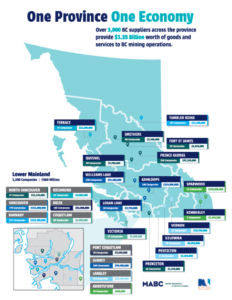For Immediate Release
September 12, 2018
All B.C. communities are mining communities
WHISTLER, B.C. – Today at the annual Union of B.C. Municipalities Convention (UBCM), the Mining Association of British Columbia (MABC) released information confirming that communities throughout British Columbia benefit from a strong and vibrant mining sector.
MABC and the Mining Suppliers Association of BC (MSABC) partnered to collect data on the economic benefits to Indigenous and local economies from 13 major metal and coal mine operations in British Columbia. The data shows that more than 125 municipalities and Indigenous communities have more than 3,000 businesses that support all aspects of B.C.’s mining operations.
“This data confirms that all communities in B.C. are mining communities, and clearly illustrates that British Columbia is ‘one province, one economy’ with rural, urban and indigenous communities working in partnership to deliver opportunity and prosperity,” said Bryan Cox, President & CEO of MABC. “A thriving and growing mining sector can continue to deliver prosperity, jobs and investment to all communities, including the lower mainland and Vancouver, while providing the essential metals and minerals for our transition to a lower carbon economy.”
Approximately 3,000 B.C. suppliers are providing $1.35 billion worth of materials goods and services to six metal mines and seven coal operations across the province, including more than $460 million of goods and services from 1,200 suppliers located in Vancouver and the lower mainland.
“We cannot take the mining industry for granted. We need to ensure B.C. is a competitive jurisdiction with consistent, clear and coordinated regulatory structures, to allow for our operating mines to continue to be viable and new mines to be built,” concluded Cox. “It is essential that government, industry, indigenous peoples, and communities continue to work together to ensure the competitiveness and viability of the mining industry.”
The B.C. mining industry is foundational to the province and represents $11.7 billion in economic activity, over 30,000 direct and indirect jobs across all regions of the province, and $859 million in contributions to governments, supporting B.C.’s essential public services.
“Our government understands that a thriving mining sector is essential to building a strong, sustainable economy that works better for more people,” said Bruce Ralston, Minister of Jobs, Trade and Technology. “This data really illustrates the spin-off effects that the mining sector has, right across B.C., with rural, urban and Indigenous communities working in partnership.”
B.C.’s mined commodities are driving our transition to a lower carbon future. B.C. is Canada’s largest producer of copper and steelmaking coal, the second largest producer of silver, and the only producer of molybdenum. These commodities are critical to the development of solar panels, wind turbines and clean energy vehicles (CEV). A CEV can require up to four-times the amount of copper as a standard combustion engine.
“These results show that even if you don’t live next to a mine, there is a good chance your community is benefiting from B.C. mining operations,” said Rodger McLean, Senior Manager, Innovative Solutions at Metric Modular and Chair of the Mining Suppliers Association of B.C.
“Workers at Metric Modular in Agassiz construct workforce accommodations and administrative buildings for the mining industry in BC and outside of the province. If you live in Agassiz, there is a good chance you will bump into a worker who has supplied mining operations located hundreds of kilometers away.”
MABC is the voice of mining in B.C., representing operating coal, metal and industrial mineral producers in the province. MABC’s mandate is to support a strong and thriving mining industry that creates opportunities and wealth for all British Columbians.
-30-
Quick facts
- There are approximately 3,000 B.C. suppliers providing $1.35B worth of materials, goods and services to 6 of B.C.’s metal mines and 7 coal operations.
- The municipalities that make up the lower mainland, from Abbotsford to West Vancouver, cumulatively have approximately 1,200 companies that benefited from more than $460 million in spending.
- The municipality with most number of vendors active in B.C.’s mine supply chain was Kamloops with approximately 390 suppliers benefiting from nearly $219 million in spending.
- The City of Vancouver had the second most number of suppliers accessed with approximately 370 companies benefiting from $142 million in spending.
- Results are based on procurement data collected by iTotem – www.itotem.ca – on behalf of MABC and MSABC from 6 metal mines and 7 coal operations between May-August 2018. The data set covers 2017 cumulative procurement spend as self-reported by participating mining operations.
- Eligible costs are expenditures on goods, materials and services from suppliers in B.C.
